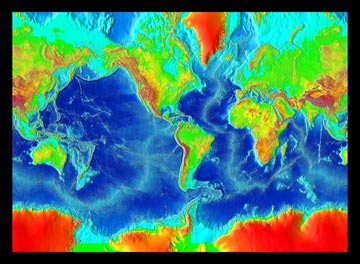The Pacific is the king of the oceans. It’s wider and deeper than the other oceans, and it covers as much area as the Atlantic and Indian oceans combined.
 Mercator projection of the world depicting the ocean basins. Credit: National Oceanic & Atmospheric Administration
Mercator projection of the world depicting the ocean basins. Credit: National Oceanic & Atmospheric AdministrationBut the Atlantic is gaining on it: It’s growing wider as the Pacific gets narrower. It’s all part of the process that created the ocean basins in the first place.
The basins are the deepest part of the oceans -- a mile and a quarter deep or more. They’re constantly changing as the result of processes below Earth’s surface.
Earth’s surface layer consists of more than a dozen “plates” -- fairly thin layers of rock that float atop another layer known as the mantle. Hot rock from the mantle pushes upward in the middle of the oceans, creating new crust. This process pushes around the plates that make up the continents. As those plates move, the configurations of the oceans change.
About 200 million years ago, today’s continents were jammed together to make a single supercontinent. And they were surrounded by a superocean.
But the continent split apart, with the pieces drifting away from each other as new crust welled up between them. As North America and Europe split apart, the North Atlantic basin formed. The South Atlantic formed several million years later. And just five million years ago, the Atlantic and Pacific were cut off from each other when the North and South American plates collided.
So the ocean contours we see today are the result of hundreds of millions of years of shifting continents -- a process that continues today.

